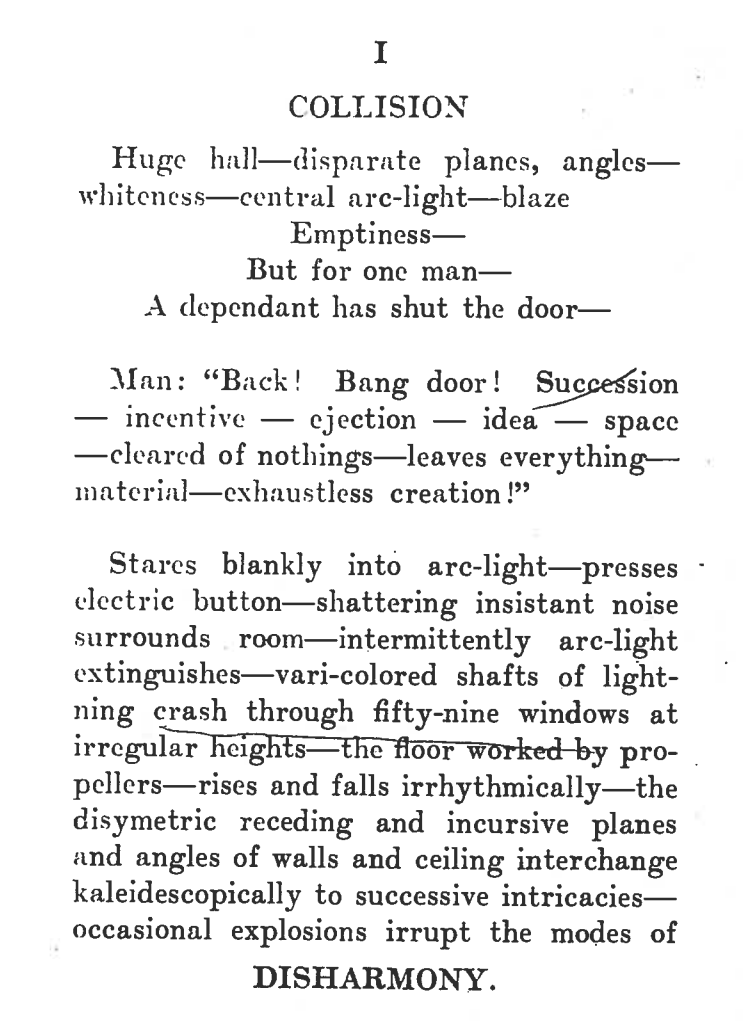By Leah Mell
Davidson College, Class of 2019
Davidson Research Initiative Grant (Summer 2018)
 Rooted in Futurist theatrical aesthetics, Mina Loy’s play “Collision” explores the impact that advances in technology and science can have in performance. In my reading, however, Loy is not ascribing entirely to the Futurist mode of theatrical performance with “Collision,” but rather drawing from the common Futurist motifs of dynamism and mechanism in order to create a new avant-garde expression that renders a physical realization impossible.
Rooted in Futurist theatrical aesthetics, Mina Loy’s play “Collision” explores the impact that advances in technology and science can have in performance. In my reading, however, Loy is not ascribing entirely to the Futurist mode of theatrical performance with “Collision,” but rather drawing from the common Futurist motifs of dynamism and mechanism in order to create a new avant-garde expression that renders a physical realization impossible.
In writing her play, Loy anticipates a technical capacity that would not exist for nearly a century after her script was published. She deviates from the expected Futurist “Theatre of Variety” with its “simultaneous movement of jugglers, dancers, gymnasts, varicoloured riding troupes” and its audience that “noisily participates in the action” (Marinetti 189). She takes the simultaneous movement of a number of performers and replaces it with a multitude of inanimate vibrating windows and lights; she takes the rambunctious, interactive audience and replaces them with a singular actor onstage pressing an electric button. The traditional theatrical audience, then, become voyeurs to this action, further removed from the world of the theatre. Thus, the set becomes actor, the actor becomes audience, and the audience becomes necessary abstraction. As an abstraction, the audience is able to have an experience beyond the expected physical engagement.
In my 3D animation, I focus primarily on the performative nature of Loy’s drama, as opposed to the text on the page as its own entity, as my goal was to realize the piece in a kind of digital performance. In “Collision” the Futurist Man becomes an audience to his own plays, removing his central personality and charisma, and we, the audience, watch his watching, freed of our own limitations and expectations as an audience member. In this abstract world, the window-actors are sexless and exempt from the layered performance of gender, and though the curtain may still be called to fall at the end, Loy is pushing theatre away from physical space and toward an abstract performance that could not have been realized at the time or for many years following. Though twice published in Rogue, Mina Loy’s play “Collision” has never been staged, and Loy’s stage directions for “Collision” would be impossible to carry out on a real stage. Shattering glass would cause danger for audience and actor alike and rigging a fly system to create matter-shifting vibration would be prohibitively expensive if not fully unrealizable. In her imagining of the play, Loy anticipates the ability to transcend physical constraints, projecting the power of a simple “electric button” to cause a “pandemonium of sound and motion” and a “vibration” that fundamentally changes the order of matter (Loy 8).
Loy’s eccentric play finds new expression in my chosen form of a 3D animation in Blender, as the screen necessary to view the piece acts as a barrier between the theatrical audience and the scene—an unbreakable fourth wall—necessary for Loy’s perversion of the Futurist theatre in which there exists only “blaze Emptiness” and the audience are merely voyeurs held captive just beyond the immediate scene (Loy 8). The fixed point of the camera in my rendering also works to further the mechanism and voyeurism, pinning the audience to a single point and making them another cog in the machine of inanimate actors. My rendering of “Collision” features Futurist elements of dynamism and industry, as Loy’s original script does, but prevents audience participation and physical engagement, emphasizing the intentional estrangement of this work from the Futurist theatrical tradition of Loy’s age.
By working with Loy’s play so intimately throughout this process, I have come to more fully appreciate the capacity of her imagination. Despite having significantly more advanced technology available to me than Loy had when she wrote this piece, I still had a hard time fully realizing many of the effects that she envisioned. Though people tend to believe that digital tools allow us to fully transcend physical limitations, I discovered that I was still bound up in the tools that I had at my disposal and in their failings in ways that Loy’s imagination was unbounded. Always at the heart of my digital work was Loy’s text and her vision, which I carefully plotted through every step of the process, and the final product reflects a new realization of this text beyond existing as words on a page. But Loy’s creation continues to challenge and trouble even the technology available today, making it all the more powerful and effective.
Works Cited
Loy, Mina. “Two Plays.” Performing Arts Journal, vol. 18, no. 1, 1996, pp. 8–17.
Marinetti, Filippo. “Futurism and the Theatre: In Praise of the Variety Theatre.” Mask, Translated by D. Nevile Lees, vol. 6, no. 3, Jan. 1914, pp. 188–193.